#parts work
Explore tagged Tumblr posts
Text
fic where kim develops shivers?
1. do we need this? 2. how badly do we need this? 3. i'm already writing it, please need this.
idea inspo from @zoetheduckling beautiful art: https://www.tumblr.com/bagmanunlucky/779845837859815424/zoetheduckling-my-liege-i-have-been-searching
i'm a writer & researcher, but it's my first fanfic for the characters running through my mind 24/7 since 2019. i flesh out the outline, themes, emotional arc, etc. constantly. focus is shivers, but also viewing skills through the lens of internal family systems (IFS) work. kim is so repressed, his parts need the help of a certain sorry cop to let his exiled parts surface and get in touch with his Self.
i have never been obsessed with something as much as de or kim kitsuragi. if you like a writing style that's been trying to emulate Kate Chopin, Rupi Kaur and Stephen King their whole life, stay tuned!
update for those interested:
i love all the people asking to be tagged when i eventually post it, but i fear i prematurely teased my fic because of how long my research and writing process is. i can't do wip because i don't write chronologically and also i don't wanna do wip cause that seems anxiety inducing. lol if anyone wants to be a fic writing accountability buddy please comment <3

#disco elysium#harry du bois#kim kitsuragi#de#de skills#de fanfic#de harry du bois#de kim kitsuragi#de harry#de kim#de shivers#writers and poets#writers on tumblr#lgbtq fanfiction#lgbtq characters#lgbtq#lgbtqia#kimharry#harrykim#RCM#Revachol#supernatural#smutty smut smut#smutty#sorry cop#art cop#bagmanunlucky#rtrg42#ifs#parts work
127 notes
·
View notes
Text
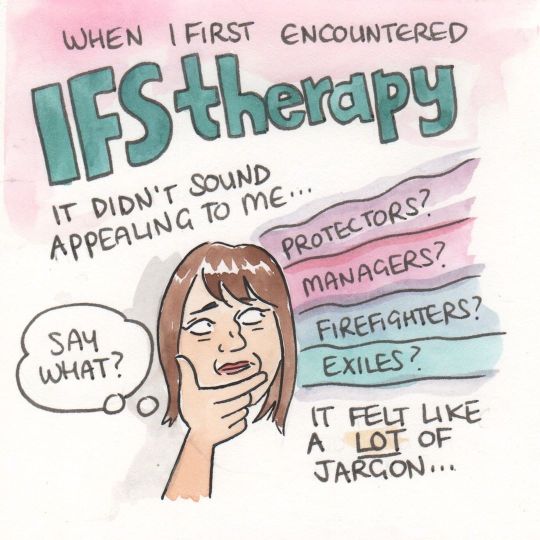









Internal Family Systems (IFS) explained [x]
#Internal Family Systems#IFS#IFS Therapy#parts work#psychology#awareness#spirituality#emotion#emotions#feelings#feeling#Sacha Mardou#mardou_draws#Mardou
178 notes
·
View notes
Text
*guy walking out of an internal family systems therapy session covered in blood* haha you should see the other gu— I mean. *remembers he IS the other guy* oh my god…..
70 notes
·
View notes
Text









#endos dni#anti endo#system userbox#system userboxes#plural userboxes#plural userbox#alter userboxes#alter userbox#sysbox#sysboxes#osdd userboxes#osdd userbox#did userboxes#did userbox#facet userboxes#facet userbox#parts work#parts therapy#ifs userboxes#ifs userbox#ifs system#ifs therapy#userbox#userboxes#requested userbox
42 notes
·
View notes
Text
Meet my “Inside Out” crew!
I’m doing “parts work” in therapy. It’s where I take aspects of my personality or emotions and assign them a name/face. These are not DID alters, it’s more like a poker hand where they’re all there all the time, it’s just some may be in conflict or upset. I assigned them an appearance or a fictional character that I feel matches them.
For example: I’ve realized I have outward trauma reactions when Trauma and Angry Fighter clash. They want to fight because they have the same goal and can’t agree on how to achieve it, so I have to step in as the core and keep them apart.
A big chunk of my therapy is figuring out what all these parts do and what they want.
So let’s meet them! Strap in, there’s 10 of them.
MY PARTS

Seasonal Anxiety— transparent deer in the woods, usually feels caught in headlights of oncoming vehicles. This poor thing pees cortisol everywhere all the time. She knows there is danger in all directions, from tigers, hunters with guns, vehicles and unseen holes in the dark. She is afraid to move because it might mean she gets hurt or causes someone else to get hurt. She doesn’t feel heard when she cries out in warning and gets hit by cars a lot, but still she tries to warn when she sees the light beams from Watchtower. She is terrified of the other parts, but Curious is taking notice of her existence. Angry Fighter is the only part that listens to Seasonal Anxiety, with disastrous effects. She is terrorized by Trauma during traumaversaries.
Territory: Amygdala, often hijacks the limbic system.

Watchtower— a lighthouse on a cliffside overlooking the sea. It is the hypervigilance always scanning every horizon for danger and distress. If anything on the horizon changes, it activates whatever other parts need to wake up to act. It NEVER turns off. The light will be bright or dim, but it is always on, sweeping, waiting. Its beam gets distorted by Black Hole Depression, which pisses off Angry Fighter and scares Seasonal Anxiety with constant false alarms.
Territory: occipital lobe, though the beam sweeps the whole brain.

Angry Fighter— Monsterverse Godzilla, big, angry, can topple a city and destroy everything in his path. He sees the danger and fear and responds by trying to fight, to restore balance, because that’s what Monsterverse Godzilla’s role is in those movies. He doesn’t tolerate what he thinks is injustice and is very loud about speaking up when anxiety isn’t stuck in the way. Curious tries to reason with him and he just steps on her and tramples over Imaginative Writer during his fights with Black Hole Depression and Trauma.
Territory: sleeps in the cerebellum, roams the limbic system, likely to hijack the amygdala and frontal lobes when rampaging.

Curious— 13th Doctor from Doctor Who, she is the one who asks questions, wants to know all the reasons for everything and runs around through time and space looking for answers. She is hungry to understand what all this means and how all these parts connect. She tries unsuccessfully to reason with Angry Fighter and is trying to talk to Seasonal Anxiety. She’s afraid of Trauma, but wants to understand him.
Territory: cerebral cortex, prefers higher thought areas.

Imaginative Writer— a tiny mouse in a tiny office typing on the tiniest keyboard you’ll ever see. She wrote all these profiles and she does the work of translating concepts into words. Sometimes she squeaks out ideas and sometimes the other parts listen. She writes all kinds of fanfiction, though not all of it gets typed, and she gets absorbed in fictional stories. Curious and Bubbly Butterfly are her buddies, they feed her creativity. Battles between Angry Fighter, Trauma and Black Hole Depression demolish her office frequently, which she hates. She activates Watchtower and Seasonal Anxiety with her squeaks when things go awry. All she wants is for the noisy parts to shut up and leave her alone to type in peace!
Territory: Precuneus region, with messages sent to Wernicke’s area and Broca’s area.

Critic— looks like Rita Repulsa from the Mighty Morphin’ Power Rangers and she barks in her screechy voice at everything the other parts do. She never has anything nice to say and makes everybody else feel like crap. She’s almost as hated as Black Hole Depression. Angry Fighter stomps her fortress all the time and she just rebuilds it and carries on being nasty.
Territory: Cerebral cortex, where she sometimes punches down into the limbic system or hippocampus.

Bubbly Butterfly— a sparkly, iridescent butterfly surrounded by bubbles, her sparkling wings and bubbles act as a shroud to cover up the other parts. She flits around, lighthearted, making jokes when things get bad and tries to be social, though it often falls flat. People often find her irritating. She just wants to be liked and to make people feel better. Trauma and Black Hole Depression terrify her and she unsuccessfully tries to keep them hidden from everybody else.
Territory: limbic system and frontal lobes.

Black Hole Depression— a black hole that bends time, space and matter around it. It absorbs everything, it is in excruciating pain, it feels unloved, unheard, ignored and dismissed. Oftentimes it doesn’t care what happens to it or those around it. It is afraid anyone who comes too close will be sucked in or flung away. It unbalances and distorts everything by sucking up too much serotonin and spitting out norepinephrine as radioactive jets. It thinks it destroys everything it touches. NOBODY LIKES IT. Everybody is afraid of it except Angry Fighter, who often steps in and starts fights to keep the balance. I don’t know what purpose it serves.
Territory: basal ganglia, with its gravity affecting the orbitofrontal cortex the most.

Trauma— Godzilla from “Godzilla Minus One”, is sometimes hidden in the glare of Black Hole Depression’s accretion disk. They’re in a symbiotic relationship. Everybody except Angry Fighter runs for cover when Trauma emerges, and Black Hole Depression tends to follow the paths of his rampages because it’s free food. He’s in pain, enraged, hates everything and wants whatever woke him up to be obliterated. When he wakes up and rampages, he destroys everything in his path. He terrorizes Seasonal Anxiety with roars and stomps during traumaversaries, to never let her forget. His atomic beam throws the entire brain into chaos. Angry Fighter tangles with him sometimes, but it's always a draw.
Territory: orbitofrontal cortex until he rampages, then the entire brain is caught up in his wrath.

Insight— Piccolo from Dragonball Z/Super. This quiet part is an observer that prefers to sit off to the side from the others and contemplate. He is responsible for the other parts being discovered, he directs the core to Curious when questions arise, and he wants the core to believe in herself more. His sphere of influence seems to grow during training, and he trains whenever the core is in a therapy session or practicing what she learned from her therapist.
Territory: Hippocampus, but his training takes him to the limbic system, precuneus region and cerebral cortex.
#therapy#parts work#my inside out crew#deer#Godzilla#piccolo#13th Doctor#Rita Repulsa#lighthouse#black hole#mouse#water#long post under the read more
16 notes
·
View notes
Text

#ifs#ifs therapy#parts work#mental health#recovery journey#healing journey#healing from the past#forgiveness#forgive your past self#love yourself#love your past self#protect your peace#i carry all my past selves with me
19 notes
·
View notes
Text
I did some intropection and gave each one of my subpersonalities a small disco-elysium inspired portrait. Part 2
CW for NSFW themes and blood
BURROWS
A small animal that sits on my shoulder and sleeps in a burrow. Another one that isn't always there and mostly just chimes in throughout the day. It's responsible for my sense of direction, social and spatial awareness in urban conditions. Which is surprisingly specific but also really useful especially in disorienting situations and new conditions. It singlehandedly saved me from sensory overload in so so many cases. When I'm at home for an extended period of time (on in the countryside) it hibernates.
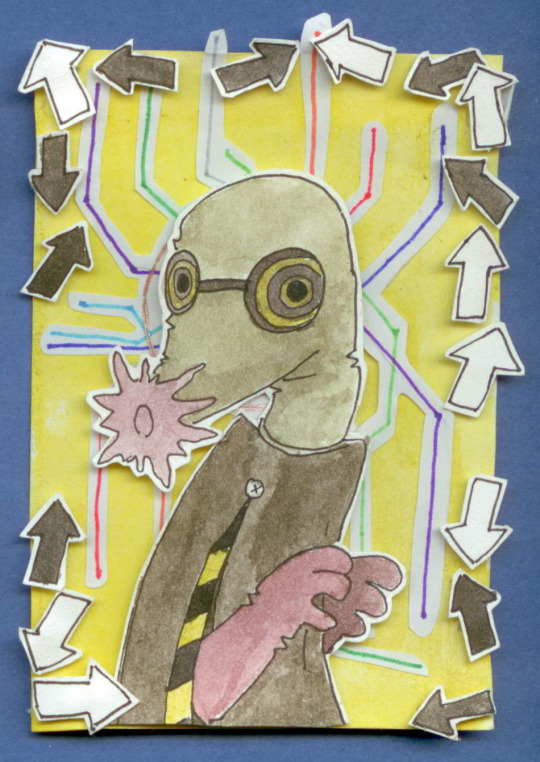
SCHADENFREUDE
A 7-meters-long rattlesnake-person. The sonuvabitch creature that gives me intrusive thoughts as a means to get attention. He seems to be incapable of empathy and actively seeks out things to gloat at. Which means he hates seeing other people have fun and likes when something bad happens to anyone other than me. He's still a part of me that I accept and love, no matter how hard it is. Also, his jokes although grim are absolutely hilarious.
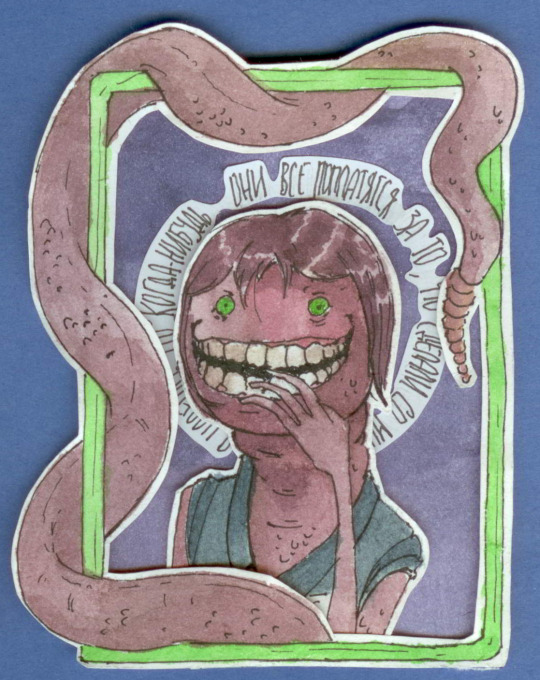
THE MARTYR
His entire body is one big bleeding wound. I'm not sure if similarity in appearance to Curly Mouthwashing is coincidental or not. Another part that thrives on attention, but unlike Freude, he demands it from other people. Don't get me wrong, I do believe that he's actually suffering, but I often catch him lying or exaggerating to gain more sympathy. He's troubled, but he has some real artistic talent and he's the only part of me that enjoys writing anything other than comedy.
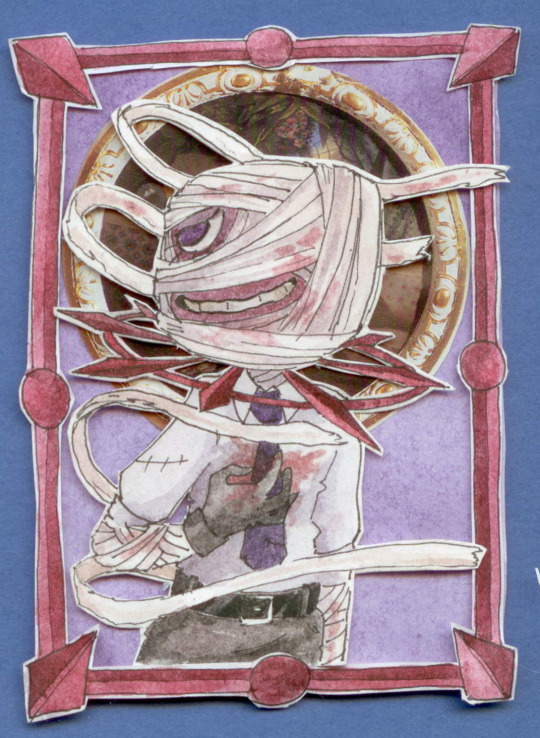
CHEMOTAXIS
Very obvious Disco Elysium inspiration aside (I'll explain the thought process in a later post), it's a subpersonality that I have the most difficult relationship with. They have been exiled and brought back multiple times because they keep getting me into trouble and because other subpersonalities seem to be on asexual spectrum. I'm really struggling to integrate them into my system.
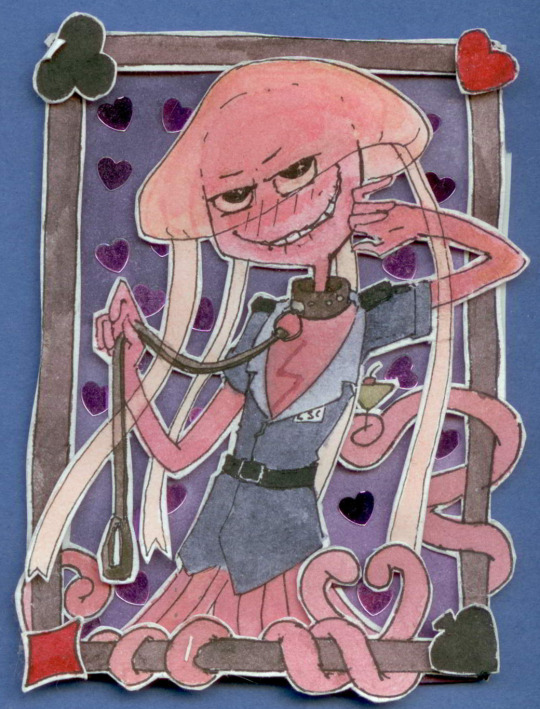
THE LIQUIDATOR
This creature is a little hard to describe. They're kind of an absurdist, they believe everything and nothing at the same time. They don't have an agenda or a moral compass but they're responsible for most of my unfiltered creativity. But their real job is liquidating mental distress - they just make me dissociate.
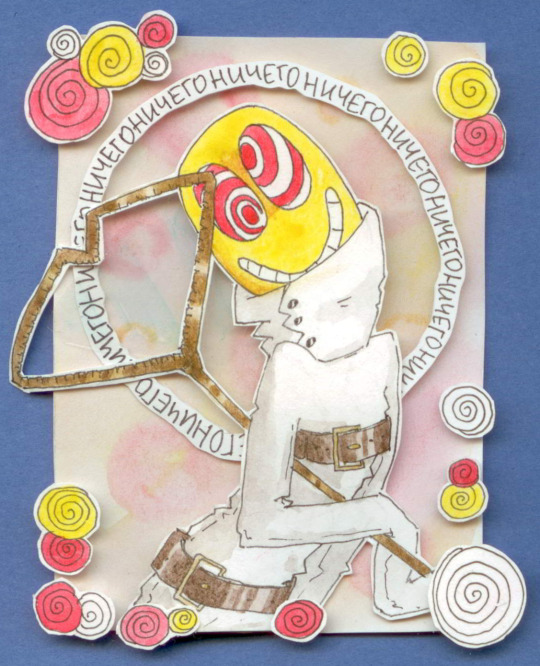
7 notes
·
View notes
Text
Parts work is challenging when your loudest part is avoidance
#avoidance#parts work#internal family systems#umbra is so loud this month#i have an appointment tonight and i want to cancel it so bad hahaha
49 notes
·
View notes
Text
EMDR #6 pt 2
I attempted actual EMDR.
After we came back from the short break, I sterted to get super anxious about even trying to do EMDR. It was partially about just not being able to tolerate it or do it, the fear of getting or feeling trapped in it and it being too much and not being able to communicate that or stop it since thats a common feeling for me. ET talked me through what it would look like and explained how it would go. We were using the buzzers for bilateral stimulation, which i know for me is a better option than eye movements since I cant usually keep my head up or maintain eye contact during sessions.
The bigger fear was more about when we actually get to working on addressing the mom stuff though. I expressed how im so afraid to have these conversations and even thoughts because I dont know how it will change things in the relationship (with my mom and others) and the stress in the family if there was that shift. ET is not and has never told me to change my relationship or level of contact with my mother, but its more that I know that the relationship is unhealthy and unhelpful for me and affects everything so im afraid to address and acknowledge things. ET reassured that anxiety that us talking about it or doing something with this does not mean anything needs to or will change and that we are also not making any decisions right now about anything. Im reminding myself that we are doing this work because I am struggling to do therapy and help myself with trusting the people who are trying to help me. The trust, lack of it, is one of the barriers and affects all my relationships too.
It took a bit but we determined a work situation that would be a good "tester" situation/theme to trial doing EMDR with. I took the buzzers and we started to talk about work. She set it up beforehand that we were going to have the scene be a movie on a big screen so we are just watching it as we talk about it and do the EMDR. She had me imagine my dog being next to me since hes a good grounding resource for me but also mentioned that we'll do more work to build up the supporitve resources for doing EMDR. The situation is that were understaffed at work most days so my anxiety builds a lot as im driving in and coming onto my shift knowing were gonna be busy and the assignments will be hard. So I imagined the room where we start our shifts by doing huddle, basically a quick meeting with updates on the unit, hospital, kids, families etc. ET asked about what the belief is that we could use and its the "I cant do this" and just the huge overwhelm of anxiety. I said the replacement belief id like to feel is that im capable of providing good care to the kids even if its stressful, busy and understaffed. We moved on to the somatic sensations which was tightness, particularly in my arms, and freeze. We were doing the bilateral stimuation with the buzzers and I did notice some movement and change in the sensations as the tightness moved down my arms and shifted to a more heaviness.
We somehow ended up in a more parts work approach because we were talking about the "I cant do it" and the overwhelm and she was asking about what the imagry with it was. It was myself curled in a smallest ball/fetal position (which is often how I am in therapy sessions and outside of them) trying to keep myself safe and bringing down the distress. She was coaching me to try to imagine a kind, caring figure comforting me and reassuring me that its ok. For a quick second I actually was imagining my grandmother being the caring figure with me in the room. I wasnt super close to her but she was always a kind caring safe person in my life growing up when I did see her. She used the examples of how i would respond to a baby or kid at work in those moments of dysregulation, so things like physical comfort with touch and holding. My judgemental critic immediate came out strong and blocking it. ET tried to guide me through imagining that part on the other side of a soundproof wall where it could still be there, but didnt need to be involved or control it. That part was too strong though, telling me to get over it, deal with it, grow up and be stronger. It was short lasting before I started to fully panic and wasnt able to seperate from that.
I was spiraling with the shame that I couldnt do it, do the EMDR all the way through, once again. ET tried to normalize that she often does little bits of EMDR intertwined with parts work and then more somatic based regulation skills and was just generally trying to say that it was OK and that we would keep working on it.
Because the imagry of curling up and being in a ball was what we were focusing on, the urge and sensation in my body to physically do the same was so strong and loud and I really struggle to not do it. I expressed that I needed to stop and asked if I could put the buzzers down which ET was fine with so i placed them on the couch. I was able to verbalize the need to curl up but also how I didnt want to do that because it doesnt really help me regulate and usually actually increases the panic, hyperventilating and distress. ET suggested me taking a blanket nd wrapping it around myself and then crossing my arms across my chest and gently rubbing them with the opposite hand to get the bilateral stimulation and I believe some comfort or safety too. I did accept the blanket but had it in my lap and was gripping on to it. ET had her blanket wrapped around her shoulders the way she was trying to encourage me to do, but that felt too hard for me. I also wasnt able to rub my arms or do that piece but i did have one finger that was keeping some movement in my body. These 2 things were also the homework she gave me to try to work on, especially in my therapy with PT. I realized after that I think the main barrier to me even attempting these things is that i cant fathom the thought of comforting or being kind to myself. Its the opposite of what I deserve. And it feels like itll just feed the neediness and the weakness instead of a harsher approach which would stop it.
5 notes
·
View notes
Text
parts work is wild
#the way parts interact with me and are so ingrained in my writing process is insane#personal#mine#parts work#ifs#ifs therapy#internal family systems#my wholesome loves i love them so much
17 notes
·
View notes
Text

Who’s afraid of little old me?
#not inspired by the song but the vibes match#illustration#comic art#religious trauma#leaving religion#mental illness#black and white illustration#comic illustration#comics#ex christian#inner demons#darkness#demons#spiritual art#parts work#jungian psychology#shadow self#taylor swift#who’s afraid of little old me#procreate
12 notes
·
View notes
Text
I want to talk about something that I have never seen mentioned on this website before. That is, the duality of alter lists. And tangentially, switching multiple times to chat with people online.
When I was first coming to terms with this diagnosis, I too made an alter list with basic info and shared it with people I talked to. It was a trend in the groups I ended up in.
What is interesting was the info I dug up for those lists was TRUE but not AUTHENTIC. Let me explain that.
Factually, the information was mostly accurate. But I am not sure exactly how I came up with it. I dont know if it was a mischevious part sharing personal info behind their backs, if the info was floated to me willingly, or if I ripped the info out of my own mind (probably doing some damage in the process). At the very least, it seemed to do some damage to my relationships with these parts.
Actually MEETING these parts has turned out to be a radically different process than learning about them was. It has been a process of years and building up trust. And yes, my original info was true, but it lacked DEPTH. My 4 or 5 main parts are so, so much more than the pithy information I originally had. Reducing them to some simple info on a list simply does not do them justice. Getting to know THEM and not facts about them has been a radical and humbling series of events. I am so much more connected to them now, and I am coming to love them as fully developed parts now. These 4-5 main parts were all ANPs at one point, and were around long enough to develop their own trauma before passing the torch to a new primary ANP. They really are fully developed, and it will be a long time before they integrate, if they ever do. Those alter lists also reduced the EPs as well though, reducing their trauma to words on a page, intellectualizing information that desperately needed to be experienced, felt, and processed. Again, nothing on those lists were wrong, and they had their own uses. But they were... awfully reductionistic and left me wholly unprepared for the complexity of those alters.
Getting the information on those lists from the mouths of the parts themselves means so, so much more than having the factual info. It is useful and has its place, I think, but its not an end-all, be-all.
Now to the tangent mentioned at the beginning. If I am only recently meeting these parts, how was I switching multiple times to talk to people online? Honestly? I do think that was a different part entirely. I think they knew each alter well enough to know how they would respond and fed me that information. I think it was a third party alter who was helping me adjust to the idea of having DID. Without the added stress of bridging the gap with these parts to genuinely interact with them. A form of exposure therapy, essentially, from one of my own parts. None of that info was WRONG, but again, it wasnt AUTHENTIC.
So this is how I've made sense of my journey with my personal growth and online communities. I would love to hear any thoughts, reflections, or experiences others have.
85 notes
·
View notes
Text
Hello! We’re @partsofafaeling or the Dollhouse System
Either works
We use mostly parts language and IFS language but we’re pretty sure we’re OSDD1a or PDID
We would LOVE requests and look forward to yours!
We are anti-endo, anti-mixed origin, only stand by Traumagenic and have no interest in syscourse
I prefer pro endos to not use my boxes but I’m also not going to be surprised if endo supporters do use my userboxes or request anonymously
Just know I block freely
#endos dni#anti endo#plural userbox#plural userboxes#sysbox#sysboxes#system userbox#system userboxes#alter userbox#alter userboxes#osdd userboxes#osdd userbox#did userbox#did userboxes#facet userboxes#facet userbox#userbox#userboxes#ifs userbox#ifs userboxes#parts userbox#parts userboxes#parts work userbox#parts work userboxes#parts therapy#parts work#ifs system#ifs therapy#ifs#internal family systems
31 notes
·
View notes
Note
we recently told our therapist about ourselves and we was quite understanding. She has a focus on trauma reprocessing so I think she has a background in this in some way.
Anyway, she sent us some information on Internal Family Systems. it was out first time hearing about this and as a general framework this makes a fair amount of sense for us.
We brought it up to our partner system who shared reservations about IFS and after reading more about it, we see where they're coming from.
Have you encountered IFS before? If so, is there any literature you've that you recommend? We're generally curious for the opinions of other systems, as we see the value in it as a framework for understanding ourselves and also the problems with it for what feels like reducing the experiences of other systems, particularly those with DID/OSDD.
hey, we have a little bit of experience with ifs through therapy and reading about it online. online, we have seen how it has been used in the past to dismiss and discredit dissociative disorders (some say that the parts mentioned through ifs disprove did systems being parts themselves). we have also seen it used to prove and affirm plurality, even plurality without trauma (some say that the parts that make them up through ifs do in fact make them plural).
our own host (hi) greatly benefits from ifs, and has been trying to understand the different parts of himself (not parts as in headmates, but parts as in parts through the ifs model) in order to show himself more kindness and self compassion. treating the different aspects of himself as separate individuals in need of care and attention has really been helping him, and we’re trying to support him in this however we can. we hope to be able to share this mindset with some other members in our system who similarly struggle with self hatred.
we think that recognizing each individual alter as their own multi-faceted person, each made up of their own parts with wants, needs, and desires, has really helped to humanize those of us in our system who were so dehumanized in our youth. each alter, each part, is complex and is capable of having their own parts that come together and make them up. does that make sense?
as far as literature, most of what we know about ifs we’ve learned through therapy. however, we currently have the book no bad parts: healing trauma and restoring wholeness with the internal family systems model (<- amazon link) on our reading list. we haven’t read it yet, so we can’t say for sure how helpful it is, but it looks like it’s going to be a good read.
we don’t believe that there’s any framework or model of viewing the self out there which is 100% good or 100% bad. not everyone is going to get something out of the ifs model, and that’s okay. if you find that ifs works for you, and that each member of your system coming to understand their own parts helps them heal and become better people, then awesome, you should definitely use it! if you find your system feels dismissed or demeaned by the ifs model, you shouldn’t be required to use it at all. not every framework is going to work for every person all the time, and that’s okay. heck, for systems, not every headmate may benefit from the same frameworks that the rest of their system uses, and that’s okay too!
sorry if this response seems frazzled or all over the place. we had completely finished responding when tumblr crashed, so we had to try and rewrite this from memory (oops). we hope that y’all can learn and grow together, with or without the ifs model. if you choose to not use it in your recovery process, hopefully your therapist will be understanding. wishing y’all the very best.
🐢 kip and 💫 parker
31 notes
·
View notes
